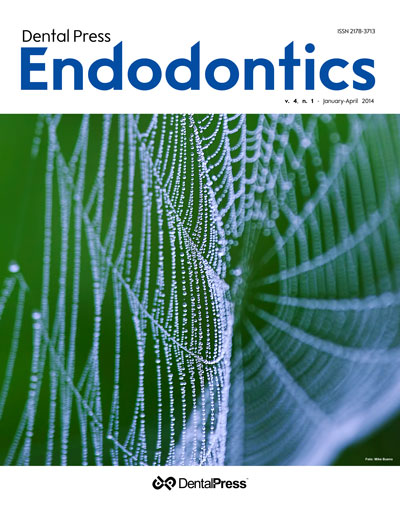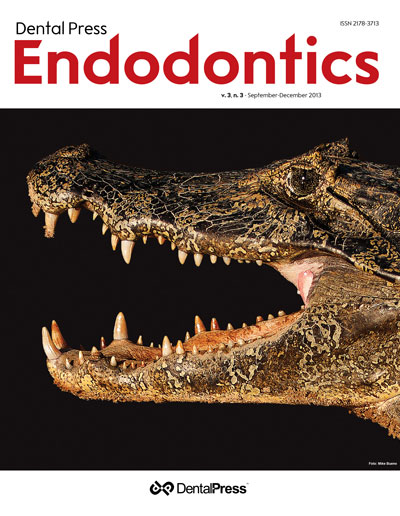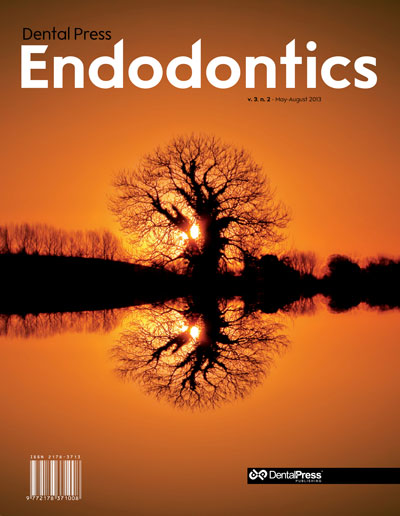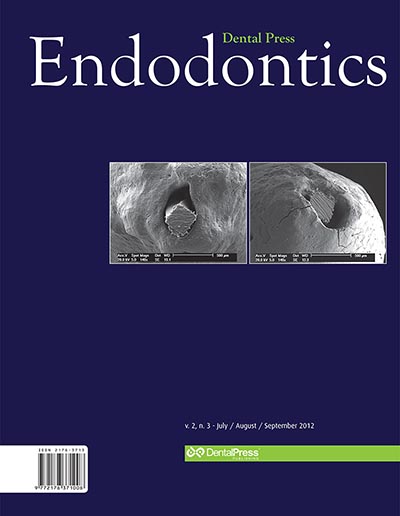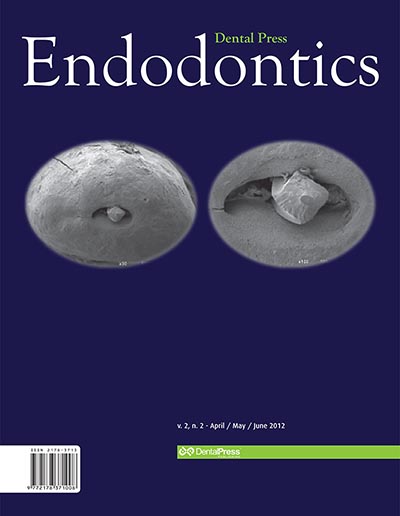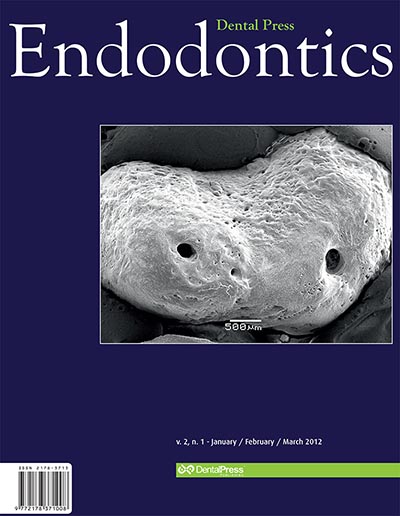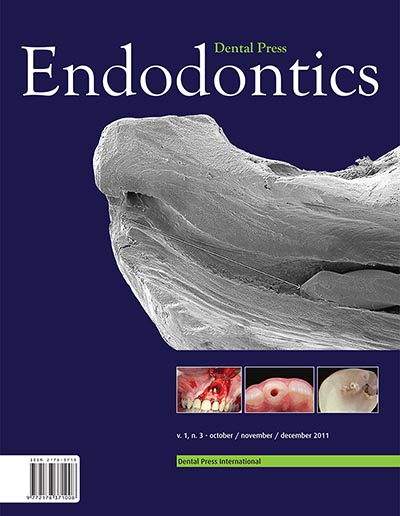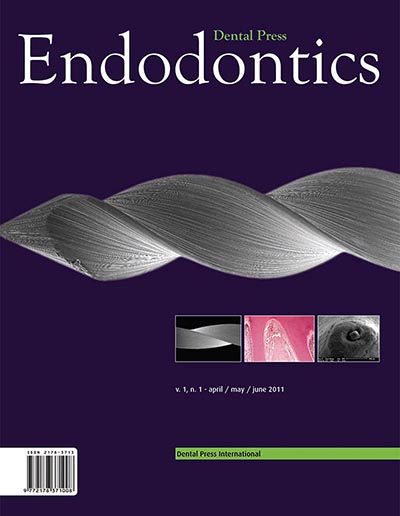v. 02, no. 3
Dental Press Endodontics – ISSN 2178-3713
Dental Press Endod.
v. 02, no. 3
July / August / September
2012
Editorial
The modern endodontic therapy
3 3
In the second edition of his book Endodontics, Ingle added a photo of the Washington Monument, representing the great integrity that seemed vital to the specialty at that time.
In its third edition, in 1985, the picture was of Mount Rainier, a massive base that rose in a spectacular ridge. Noting that mount, Ingle thought that, when reviewing the mountain of endodontic achievements, one gets impressed with the solid foundation of research and important observations that lead us to the zenith of our progress. Still, he claimed we were being crushed by an avalanche of ideas, techniques and tools, all of them exciting, some threatening and many still not adequately tested. So, for him, the intact splendor of our “mountain” of knowledge was being threatened. He wondered: Could Mount Rainier become another St. Helens, an active volcano in southwest Washington state that in 1980, after 127 years of inactivity, came into violent eruption, followed by a tremor of 5.1 points on the Richter scale, bringing the northern part of the volcano down, decreasing by 400 meters at its height and increasing its width in a mile?
Today, over 25 years later, the threat remains the same. Automated systems are launched first and tested later! The industry has been resolute in the purpose to directly influence the teaching of Endodontics. But only few educational institutions are prepared for the new technologies. And, leaving it to the industry, we face charges that do not correspond to reality. The race to disseminate new systems brings a number of concerns. As stated Spangberg in 2001, the apparent simplicity of the technique using some instruments is an invitation to ignorance. Without a deep knowledge of the anatomy and pathology, instrumentation does not increase the success rate of endodontic therapy. The reality is that the increase in sales of new systems does not necessarily mean its implementation in daily clinical practice.
It is necessary to understand that it is from the constant practice and training that we’ll execute, in automation, all the experience gained from years of manual training. But, wouldn’t the idea be going the other way around now?
Endo in Endo
Clinical and imaginologic diagnosis of occlusal trauma
Occlusal trauma. Occlusion. Gingival recession. Dental trauma. Abfraction.
10 20
A more refined diagnosis tends to be based on subtle signs and symptoms, requiring the specialist to be extremely judicious and knowledgeable. Occlusal trauma should be included in the differential diagnosis of apical periodontitis and dental trauma. Ideally, when a tooth presents with pulp necrosis and signs of occlusal trauma, one should conduct the interview and diagnostic tests in search of a superimposed dental trauma, even in posterior teeth. No scientific rationale is strong enough as to allow one to state that occlusal interference or occlusal overloads produce a necrotic pulp. Interferences and occlusal overloads take months or even years to induce the classic signs and symptoms of occlusal trauma as a clinical entity. It is still common to compare the effects of occlusal trauma to those resulting from orthodontic movement and dental injuries. The mechanisms underlying tissue changes induced by occlusal trauma are in no way comparable to those induced by orthodontic movement or dental trauma. In these three events the primary cause is of a physical nature, but the forces applied to dental tissues exhibit completely different characteristics of intensity, duration, direction, distribution, frequency and form of uptake by periodontal tissues.
Original articles
Biocompatibility and setting time of gray Portland cement clinker with or without calcium sulfate
Mineral Trioxide Aggregate. Clinker. Portland cement.
21 26
Objective: To evaluate the biocompatibility of Grey Portland Cement Clinker without and with 2% and 5% calcium sulfate.
Methods: Twenty-four mice received subcutaneously polyethylene tubes filled with grey Portland Cement Clinker without or with 2% or 5% calcium sulfate. After 15, 30 and 60 days of implantation, the animals were killed and specimens were prepared for microscopic analysis. Setting times of each material were also evaluated according to the ASTM specification # C266-08. ANOVA and Tukey’s test for setting time and Kruskal Wallis and Dum test for biocompatility at 5% significance level were used.
Results: Histologic observation showed no statistical difference among the materials in the subcutaneous tissues.
Conclusion: Clinker without calcium sulfate showed 5 min for initial setting time and 55 min for final setting time, followed by clinker with 2% sulfate calcium (8/95 min) and clinker with 5% sulfate calcium (10/110 min).
In vitro evaluation of two techniques to determine working length with an electronic apex locator
Endodontics. Tooth Apex. Odontometry.
27 31
Objective: To verify in vitro whether an electronic apical location using a non-foramen by-pass technique influences the accuracy of the procedure.
Methods: Fifteen incisors and canines human teeth with complete apical formation were used. Teeth were fixed to a resin-based model and embeded into alginate to serve as a conduction medium for the eletronical readings. Using a K-flexofile #20 coupled to the apical locator device (Root ZX II, J Morita, Kyoto, Japan), root canals were electronically measured at two different time-points. Firstly, it has been registered before passing through the apical foramen (alternative technique) and, thereafter with the file bypassing the apical foramen (recomended technique). On both techniques the readings were performed whenever the display was stabilized at level 0.5. After each electronic determination, the tooth was radiographed with the file in position. To measure the agreement between the two techniques, the interclass correlation statistical procedure was used.
Results: The difference between the two techniques at the radiographic evaluation was 0.118 mm (± 0.170) and for the electronic reading 0.086 mm (± 0.398). The two techniques were significantly correlated both for the electronic reading and for the radiographic evaluation (ICC = 0.98; p < 0.001, ICC = 0.97; p < 0.001, respectively).
Conclusion: The alternative technique for electronic apical location, without passing the foramen, has shown similar accuracy as the standard technique, sugested by the manufacturer.
Influence of the curved root canal segments length on the fatigue fracture of rotatory NiTi instruments
Curved segments length. Fatigue. Fracture.
32 35
Introduction: The aim of this study was to evaluate the influence of the curved root canal segments length on the number of cycles needed to induce fatigue fracture of a rotatory nickel-titanium (NiTi) instrument.
Methods: The instruments used in this study were Mtwo with 0.35 mm D0 diameter, 0.02 mm/mm taper and 25 mm length. The instruments were used in two artificial metallic root canals with curved segments under 300 rpm speed. The curvatures were located in the root canals extremities and had different curved segments lengths. The device used in the rotating bending test of the selected endodontic instruments was described previously by Lopes et al.1
Results: The number of cycles needed to cause fatigue fracture was influenced by the artificial root canal curved segments length.
Conclusion: The number of cycles needed to induce fatigue fracture on the instruments used at rotating bending in artificial root canals of same radius sizes decreased with the curved segments length increasing.
In vitro diffusion of hydroxyl ions from medicaments pastes based on calcium hydroxide
Diffusion. Endodontics. Calcium hydroxide.
36 41
Objective: Analyzing, in vitro, the pH of six endodontic pastes based on calcium hydroxide [Ca (OH) 2].
Methods: Six groups were formed (n = 5 pastes/group) and a control group (distilled water): GI – Ca(OH)2, propylene glycol 400 (PEG 400) and camphorated paramonochlorophenol (PMCC); GII - Ca(OH)2, iodoform 1:1, PEG 400 and PMCC; GIII – Ca(OH)2, iodoform 4:1, PEG 400 and PMCC; GIV - Ca(OH)2 and Otosporim®; GV – Ca(OH)2 and olive oil; GVI - Ca(OH)2 and chlorhexidine gel 2%. The pastes were previously placed in distilled water and stored at 37° C, and the pH of each sample was measured at seven different time intervals. The assay was performed in two steps, whereas in the second stage the distilled water was replaced after each reading.
Results: In both phases, there was no statistically significant difference between the pH values of GI, GII, GIII and GIV (p > 0.05) in the 7 time intervals evaluated. All groups showed higher pH compared to the GV and the control group (p < 0.05), which were statistically similar to each other (p > 0.05).
Conclusion: The pastes presented alkaline pH, with variations according to their composition, having a greater dissociation when a viscous substance was present in the composition.
Endodontic Treatment of a fused mandibular incisor
Ebstein Anomaly. Endodontics. Dental Pulp.
42 47
Introduction: Dental fusion is characterized by the union of two dental germs during the development stage, in consequence of the germ layer aberration in the ectoderm and mesoderm.
Objective: The purpose of this study was to describe the endodontic treatment of lower incisor with supernumerary tooth.
Methods: Patient sought for attention with spontaneous and severe pain in tooth #41. The dental element presented atypical crown, with aspect of fusion. By the radiographic image was observed the presence of single root and two root canals. It was determined the necessity for endodontic treatment, performed by nickel-titanium instruments. Each instrument exchange was carried out irrigation with 2.5% sodium hypochlorite solution and 17% EDTA. The filling was performed by active lateral condensation technique of gutta-percha associated to cement and complemented by thermofilling. The cone beam tomography was realized for the filling quality verification and inner anatomy architecture. The patient returned to clinical and radiographic control of 1 year with the tooth showing signs of normality.
Conclusion: The dentist should develop competence and ability for the adequate diagnosis of dental anomalies, providing good conditions for the promotion of patients’ oral health.
Therapeutic proposal for avulsed teeth using calcium hydroxide associated to 2% chlorhexidine gel and zinc oxide
Chlorhexidine. Dental Trauma. Calcium Hydroxide. Intracanal Dressing.
48 53
Tooth avulsion deserves great attention in dentistry due to its esthetic and functional implications. The prognosis of tooth replantation is usually related to the need of endodontic treatment, and several substances have been used as intracanal dressing. The objective of this study was to present a case of a dental replantation that was endodontically treated with a new therapeutic proposal for avulsed permanent teeth that associates calcium hydroxide P.A., 2% chlorhexidine gel and zinc oxide. A 10-year-old patient suffered tooth avulsion of both right and left central incisors due to a bicycle accident. Both teeth were replanted and endodontically treated, with different protocols. The right incisor was conventionally treated with periodic changes of calcium hydroxide intracanal medication and the left incisor was maintained with the filling paste composed of calcium hydroxide, 2% chlorexidine gel and zinc oxide during all the period of apexification, without changes. During 3 years of follow-up, both teeth showed absence of symptomatology and apical repair. This intracanal dressing played an important role as a filling paste with effective elimination of microorganisms present in the root canal system, stimulated the formation of a mineralized apical barrier, and stabilized root inflammatory resorption.
Assessment of apical third morphology in root canals after biomechanical preparation: Alternate and continual rotations (Easy RaCe system)
Dental Apex. Root Canal Preparation. Endodontics.
54 60
Objective: This study aimed to analyze the presence of apical deviation according to the instrumentation technique and instruments used during mechanical preparation of root canals.
Methods: It was carried out in vitro tests with the two types of preparation in root canals, in a total of 24 dental units divided into two groups according to the types of mechanical preparations made.
Conclusion: At the end of the experiment it was observed that there was no significative difference between the two types of instrumental techniques. This suggests a greater attention to the alternate preparation due to its low cost, being possible to include it in CEOs (specialized dental clinics) of Ministry of Health - Brazil.
CBCT and microscopic analysis of the incidence of second mesiobuccal canal of maxillary molars
Dental pulp cavity. Molar tooth. Cone-beam computed tomography. Microscopy.
61 66
Introduction: The objective of successful endodontic treatment is a complete chemical-mechanical cleaning of root canals and filling. Therefore, a root canal not located represents a possible cause of endodontic failure, due to lack of cleaning and filling.
Objective: The aim of this study was to determine the incidence of second mesiobuccal (2MB) canal in mesiobuccal roots of maxillary molars, comparing the efficacy of three methods for their identification: Cone beam computed tomography (CBCT), clinical analysis (CA) and operating microscope (OM).
Methods: The existence of the second mesiobuccal (2MB) canal was evaluated by two examiners in 42 first and second molars without pulp involvement. The teeth were subsequently evaluated by the three methods and later these mesiobuccal roots were sectioned at 3 and 7 mm from the apex in the axial plane and observed with a digital microscope.
Results: Was revealed the real presence of 10 2MB canals (23.81%). Statistical analysis by McNemar test showed that there was no statistically significant difference (p < 0.05) in the efficacy of 2MB canals localization between the three methods.
Conclusion: None of the three methods made possible the determination of the 2MB canal in all cases, however CBCT showed the better results.
The use of calcium hydroxide as intracanal medication for the apexification of teeth with incomplete root formation
Apexification. Incomplete root formation. Calcium hydroxide. Intracanal dressing. Dental traumatism.
67 73
The objective of this study was to present, through a clinical case, the treatment of two traumatized dental elements with incomplete root formation, extensive periapical lesion and root resorption. The treatment of choice for teeth with incompletely formed apices was the apexification by changing the intracanal medication to promote apical closure, periapical lesion repair as well as root resorption stabilization. The intracanal dressing, calcium hydroxide paste mixed with propyleneglycol as a vehicle, was changed a total of four times during a period of one year and two months. It has been concluded that this technique for apexification provides favorable conditions for the closure of root apices as well as repairing periapical lesions and stabilizing root resorption.
Influence of coronal opening in the location of root canals in mandibular incisors
Root canal preparation; Endodontics; Pulp cavity.
74 79
Objective: This study evaluated the influence of shapes of coronary opening on the localization of root canals in lower incisors.
Methods: It were used 32 teeth extracted from humans, being 16 with a single canal and 16 with two root canals that received, initially, conservative oval coronary opening, followed by random setting on mannequin, for clinical evaluation of number of root canals by two specialists. After that, the openings were enlarged to non-conservative triangular shape, being submitted to a second clinical evaluation regarding the number of root canals.
Results: On the examination of the conservative opening, the examiners 1 and 2 obtained, respectively, 15(94%) and 14(87%) scores for the teeth with one canal, with none (0%) and 5 scores (31,2%) for the teeth with two canals. After enlarging the opening, the examiners 1 and 2 obtained, respectively, 16 scores (100%) in cases with one canal, with 5 (31,2%) and 10 (62%) scores in cases with two canals. Between the examiners, on the non-conservative opening it was obtained Kappa = 0,456 and, on the conservative, Kappa = 0,629, determining mild concordance. According to results, the non-conservative triangular coronary opening lead to a greater percentage of scores on the localization of canals of lower incisors than the oval conservative opening, being this difference statistically significant (p < 0,05).


